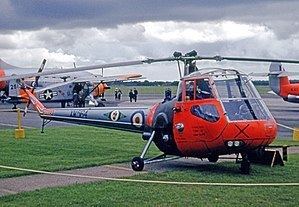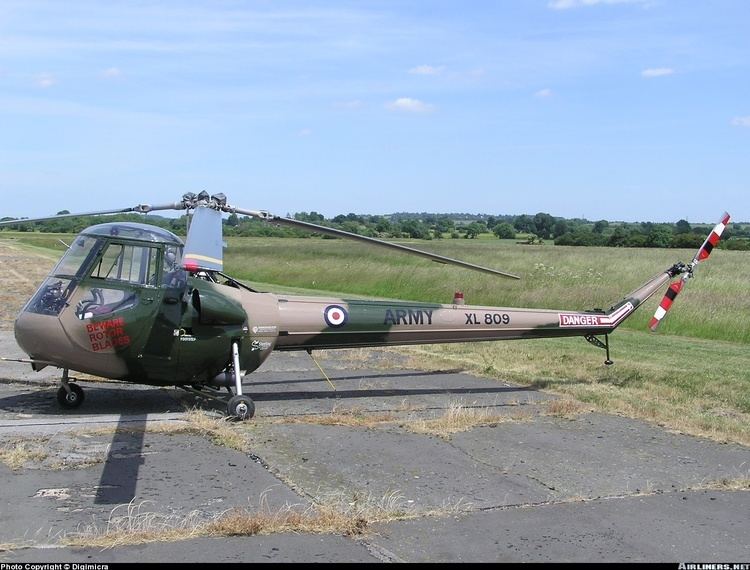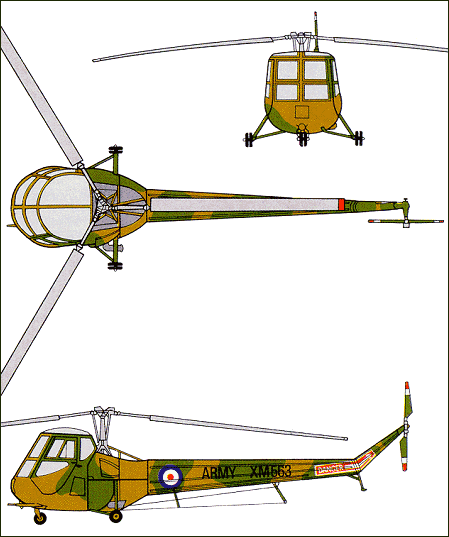Top speed 175 km/h Length 8.66 m | Wingspan 9.75 m First flight October 8, 1948 | |
 | ||
The Saunders-Roe Skeeter was a two-seat training and scout helicopter produced by Saunders-Roe ("Saro") of Cowes and Southampton, in the United Kingdom. The design was begun as the Cierva W.14 and carried on by Saunders-Roe after it took over Cierva's projects.
Contents
- Design and development
- Operational history
- Variants
- Operators
- Survivors
- Specifications Skeeter AOP12
- References

The Skeeter had the distinction of being the first helicopter to be used by the British Army Air Corps.

Design and development

In 1947 the Cierva Autogiro Company began work on the Cierva W.14 Skeeter, a small two-seat helicopter suitable for both civil use and as a military observation aircraft. The Skeeter was a single-engined helicopter of conventional configuration, with a 29-foot (8.84 metre) three-bladed main rotor and a three-bladed anti-torque rotor mounted at the end of a triangular-section tailboom. The crew of two sat in a glazed cabin, with the engine, a 110 hp Jameson FF-1 air-cooled horizontally-opposed piston engine, mounted behind the crew and under the main rotor. A fixed tricycle undercarriage was fitted.

The first prototype Skeeter made its maiden flight at Eastleigh airfield on 10 October 1948. The helicopter proved to be underpowered, and the experimental Jameson engine was prone to overheating, so it was decided to develop a Mark 2 Skeeter, to be fitted with the well established de Havilland Gipsy Major 10, giving 145 hp (108 kW). The Mark 2 was larger aircraft, with a different appearance.

The Skeeter 2 first flew on 15 November 1949, but it soon became apparent that it suffered from severe ground resonance problems that Cierva struggled to resolve, causing it to be destroyed during ground testing on 26 June 1950. Despite these problems, Cierva received an order from the Ministry of Supply for three improved Skeeters, (two Mark 3s and one Mark 4) for evaluation by the Royal Air Force and Royal Navy. These three aircraft were not completed before Saunders-Roe took over the Cierva's facilities and development programmes in January 1951. In 1953 the Blackburn Bombardier-engined Mark 3B was passed to the Aeroplane and Armament Experimental Establishment. Testing showed that these aircraft remained underpowered and that the ground resonance problems had not been resolved, causing official support to be suspended with Saunders-Roe undertaking a long series of company-funded tests to identify the causes and to identify solutions to the problems.

The solution involved a redesigned undercarriage and revised blade friction dampers on the rotor head. This allowed Saunders-Roe to finally demonstrate that the ground resonance problems had been fixed when the Skeeter Mark 5 was tested by the A&AEE in March 1954. This reignited official interest in the Skeeter, with an order for four Skeeter Mark 6s with 200 hp (149 kW) Gipsy Major 200 engines (designated AOP.10 and T.11 by the British armed forces) for evaluation, and finally production orders for 64 AOP.12s, with a 215 hp (160 kW) engine, were placed from 1956, with deliveries starting in 1958.
Operational history
The British Army ordered 64 Skeeter 6's, to be designated as the Skeeter AOP.12 (Air Observation Platform), and the Skeeter finally entered service in October 1956. Several Skeeter AOP.12s were operated by the Central Flying School of the Royal Air Force. With the merger of the helicopter activities of the British Bristol Aeroplane Company, Fairey and Saro with Westland Aircraft in 1960, plans to develop a turbine powered version were abandoned – although this knowledge was used in the development of the Westland Scout and Westland Wasp through to the P.531 which was based on the Skeeter airframe.
Variants
Operators
Six Skeeter Mk.50 and four Skeeter Mk.51 acquired from the German Army Aviation Corps and German Navy, respectively. These non-airworthy examples were delivered in July 1961 and were stored at OGMA; due to lacking spare parts their rebuild was eventually cancelled and they were sold.
Survivors
There is one remaining flying example of the Skeeter though a number are held by British museums, including the Museum of Army Flying.
Saunders-Roe Skeeter AOP Mk12 on display at The Helicopter Museum Weston-super-Mare North Somerset, United Kingdom
Another, in Army Air Corps colours is on static display in the aeronautics hall of the Science Museum, London. This example is easily viewed and photographed from the raised observation deck in the hall.
Polish Aviation Museum in Kraków also has one example on static display (AOP.12 produced in 1959).
Specifications (Skeeter AOP.12)
Data from Saunders and Saro Aircraft since 1917.
General characteristics
Performance
